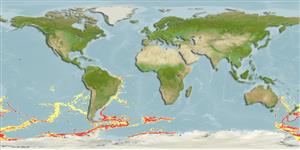Pycnogonida |
Pantopoda |
Nymphonidae
Environment: milieu / climate zone / ระดับความลึก / distribution range
นิเวศวิทยา
; ระดับความลึก 318 - 3000 m (อ้างอิง 2116). Temperate
Southwest Atlantic, South Pacific and the Antarctic.
Length at first maturity / ขนาด / Weight / Age
วัยเจริญพันธุ์: Lm ? range ? - ? cm
Size moderately large, leg span about 82 - 92 mm. Most appendages very long, slender. Trunk and lateral processes well separated, glabrous. Neck of medium length, oviger bases implanted well anterior to first lateral processes, low ocular tubercle placed between oviger bases and first lateral processes. Proboscis rather long, slender, with slight median and distal swelling. Abdomen narrow, short. Xelifore scapes longer than proboscis. Chelae very slender, palms short, fingers very long, overlapping at tips, armed with very many slender sharp teeth. Palps quite slender, third segment about 0.6 length of second, fourth only slightly shorter than fifth (sometimes subequal). Oviger fifth segment longest, slender, distally curved and swollen. Second coxae of legs unusually long, about 4.5 times longer than first coxae. Second tibiae longest segments. Tarsus sometimes shorter, sometimes subequal to propodal length, claw 0.7 length of propodus, sometimes longer, without auxiliaries. Sole of both distal segments with many very short spines (Ref. 9).
Life cycle and mating behavior
วัยเจริญพันธุ์ | การสืบพันธุ์ | การวางไข่ | Eggs | ความดกของไข่ | Larvae
Members of the class Pycnogonida are gonochoric and sexually dimorphic. During copulation, male usually suspends itself beneath the female. Fertilization occurs as the eggs leave the female's ovigers. Males brood the egg masses until they hatch. Life cycle: Eggs hatch into protonymphon larva then to adults.
Child, C.A. 1998 The marine fauna of New Zealand: Pycnogonida (sea spiders). NIWA Biodiversity Memoire 109. National Institute of Water and Atmospheric Research (NIWA). Washington, D.C. 20530, USA. 71 p. + Figure 2A-G, 3A-F, 4, 5. (อ้างอิง 9)
IUCN Red List Status
(อ้างอิง 130435: Version 2025-1)
CITES status (อ้างอิง 108899)
Not Evaluated
CMS (อ้างอิง 116361)
Not Evaluated
Threat to humans
Human uses
| FishSource |
เครื่องมือ
ข้อมูลเพิ่มเติม
นิเวศวิทยาเขตร้อนFood items (preys)
องค์ประอบของอาหาร
การบริโภคอาหาร
ผู้ล่า
Population dynamicsการเจริญเติบโต
Max. ages / sizes
Length-weight rel.
Length-length rel.
Length-frequencies
Mass conversion
อุดมสมบรูณ์
Life cycleการสืบพันธุ์วัยเจริญพันธุ์ความดกของไข่การวางไข่EggsEgg developmentLarvae Human RelatedStamps, coins, misc.
แหล่งที่มาจากอินเตอร์เน็ต
Estimates based on models
Preferred temperature
(Ref.
115969): 0.2 - 4.3, mean 2.8 (based on 605 cells).
Price category
Unknown.
